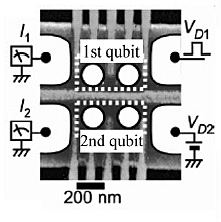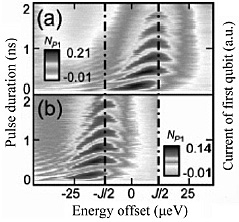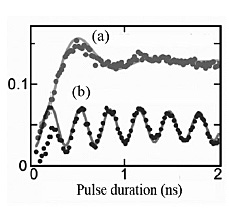Physical Science Laboratory, *Tokyo Institute of Technology
Two-qubit unitary operations are key ingredients for performing quantum algorithms and correlating multiple qubits. Typical operations, such as controlled-rotation (CROT), which rotates the target qubit state conditionally on the control qubit state, and SWAP, which swaps quantum states of the two qubits, have been demonstrated using superconductor charge qubits and semiconductor spin qubits[1, 2]. However usually one type of operations is realized depending on the type of coupling (Ising, Heisenberg, etc.). Although other operations can in principle be designed in combination with some one-qubit operations, simple sequences for shorter operation time or a smaller number of steps have been desired to maintain the coherency of the system.
In this work, using coupled semiconductor charge qubits consisting of
two sets of coupled double quantum dots (DQD), we fabricated two-qubit
device in which two spatially separated electrons in the two qubits change
their locations coherently and collectively (the correlated coherent oscillations)
and two-qubit operations such as CROT, SWAP can be performed in a single
step[3]. Figure 1 shows a scanning electron micrograph (SEM) of the two-qubit
device. The two qubits with individual source and drain electrodes are
electrically isolated, and thus independent currents can be measured simultaneously.
All qubit parameters can be controlled by 11 gate voltages. By applying
high-frequency voltage pulse to first qubit and measuring the current,
coherent oscillation demonstrating the superposition of the charge states
|0> and |1> is observed. Here, |0> and |1> represent the location
of the charge in the right and left dot, respectively. Due to the electrostatic
coupling between the two qubits, the coherent oscillation of the first
qubit is strongly influenced by the charge states of the second qubit.
Figure 2 shows the demonstration of the CROT operation of the first qubit
using the second qubit as a control qubit. Figure 3(a) shows the correlated
coherent oscillations in which SWAP operation is performed.
This work was partly supported by SCOPE from the Ministry of Internal
Affairs and Communications of Japan.
[1] T. Yamamoto et al., Nature 425 (2003) 941.
[2] J. R. Petta et al., Science 309 (2005) 2180.
[3] G. Shinkai et al., Phys. Rev. Lett. 103 (2009) 056802.
 |
 |
 |
||||||||
|
|
|